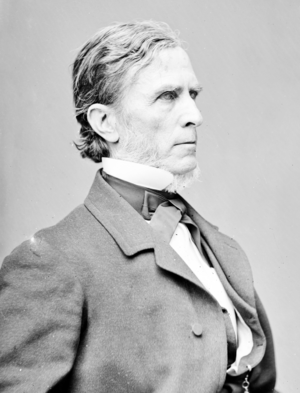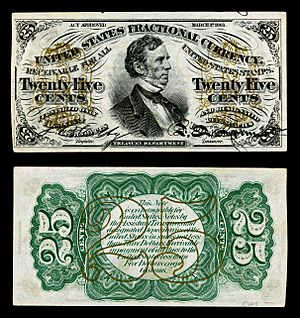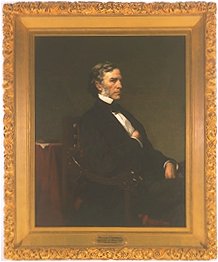William P. Fessenden facts for kids
Quick facts for kids
William Pitt Fessenden
|
|
|---|---|

Photograph by Mathew Brady
|
|
| United States Senator from Maine |
|
| In office March 4, 1865 – September 8, 1869 |
|
| Preceded by | Nathan A. Farwell |
| Succeeded by | Lot M. Morrill |
| In office February 10, 1854 – July 1, 1864 |
|
| Preceded by | James W. Bradbury |
| Succeeded by | Nathan A. Farwell |
| 26th United States Secretary of the Treasury | |
| In office July 5, 1864 – March 3, 1865 |
|
| President | Abraham Lincoln |
| Preceded by | Salmon P. Chase |
| Succeeded by | Hugh McCulloch |
| Member of the U.S. House of Representatives from Maine's 2nd district |
|
| In office March 4, 1841 – March 3, 1843 |
|
| Preceded by | Albert Smith |
| Succeeded by | Robert P. Dunlap |
| Personal details | |
| Born |
William Pitt Fessenden
October 16, 1806 Boscawen, New Hampshire, U.S. |
| Died | September 8, 1869 (aged 62) Portland, Maine, U.S. |
| Resting place | Evergreen Cemetery |
| Political party | Republican (1860–1869) |
| Other political affiliations |
|
| Spouse |
Ellen Deering
(m. 1832–1857) |
| Children | 5, including James and Francis |
| Education | Bowdoin College (BA) |
| Signature | |
William Pitt Fessenden (October 16, 1806 – September 8, 1869) was an important American politician from Maine. He was part of the Fessenden political family, which included many politicians.
Fessenden started his career as a Whig and later became a Republican. He served in both the United States House of Representatives and the United States Senate. During the American Civil War, he became United States Secretary of the Treasury under President Abraham Lincoln. After the war, he returned to the Senate, where he passed away in 1869.
As a lawyer, Fessenden was a strong opponent of slavery in Maine. In Congress, he fought against the power of slave owners in the Southern states. He helped create an anti-slavery group in Maine that led to his election to the U.S. Senate. This group later became the Republican Party in Maine.
In the Senate, Fessenden spoke out against the spread of slavery. He also criticized Democratic leaders like Stephen Douglas and Presidents Franklin Pierce and James Buchanan. His speeches were widely read and helped build support for Abraham Lincoln's election as president in 1860.
During the Civil War, Fessenden helped create the Union's financial plans. He became Lincoln's Treasury Secretary and worked to strengthen the country's money system. After the war, he led the Joint Committee on Reconstruction. This committee helped decide how Southern states could rejoin the United States.
Later, during the impeachment trial of President Andrew Johnson in 1868, Fessenden voted against removing the President from office. This vote was very important because it prevented Johnson from being convicted. Fessenden believed in free trade and worried about who would become president if Johnson was removed.
Today, three streets in Portland, Maine, are named after him: William, Pitt, and Fessenden streets.
Contents
Early Life and Career Beginnings
William Pitt Fessenden was born in Boscawen, New Hampshire, on October 16, 1806. His father, Samuel Fessenden, was also a lawyer and politician. William was raised by his grandmother for his early years.
He graduated from Bowdoin College in 1823 and then studied law. In 1827, he helped start the Maine Temperance Society. That same year, he became a lawyer and worked with his father, who also strongly opposed slavery. He practiced law in different towns in Maine, including Bridgton, Bangor, and Portland.
Fessenden served in the Maine House of Representatives in 1832, where he was known as a skilled debater. He was asked to run for Congress in 1831 and 1838 but declined. He returned to the Maine legislature in 1840 and helped update the state's laws.
He was elected to the United States House of Representatives as a Whig in 1840 for one term. During this time, he worked to allow anti-slavery petitions to be heard in Congress. After his term, he focused on his law practice until he returned to the Maine legislature in 1845–46. He became a well-known lawyer and anti-slavery Whig. In 1849, he won an important case before the Supreme Court of the United States, which even Daniel Webster praised. He served in the Maine legislature again in 1853 and 1854.
Serving in the U.S. Senate and Cabinet

An 1864 cartoon featuring Fessenden, Edwin Stanton, Abraham Lincoln, William Seward and Gideon Welles takes a swing at the Lincoln administration.
Fessenden's strong anti-slavery views led to his election to the U.S. Senate in 1854. He had support from both Whigs and anti-slavery Democrats.
As soon as he took office, he spoke out against the Kansas–Nebraska Act, which allowed new territories to decide on slavery. His speeches against the Lecompton Constitution in Kansas and his criticisms of the Dred Scott case were highly regarded. He helped form the Republican Party and was re-elected to the Senate as a Republican in 1860.
In 1861, Fessenden was part of the Peace Conference of 1861. However, once the Civil War began, he strongly believed the war should be fought with full effort. When Southern senators left Congress, Republicans gained control of the Senate. Fessenden was put in charge of the finance committee. During the Civil War, he was key in keeping the country's money system strong. He disagreed with the Legal Tender Act, which allowed the government to print paper money not backed by gold.
As head of the finance committee, Fessenden created and guided all laws about taxes and spending through the Senate. Charles Sumner said Fessenden was as important in finance as the best generals were in battle.

President Abraham Lincoln chose Fessenden to be United States Secretary of the Treasury when the previous secretary resigned. This was a very difficult time for the nation's money. The country's ability to borrow money seemed to be running out, and paper money was worth very little. Gold prices were very high. Fessenden first refused the job, but he accepted because everyone wanted him to. When people heard he accepted, gold prices dropped.
He announced that no more paper money would be printed. He asked the public for help and created the "seven-thirty loan," which was very successful and raised $400,000,000. These were bonds that paid 7.30% interest and were sold in small amounts, like $50, so ordinary people could buy them. He also planned how government loans could be combined into new bonds.
Fessenden started as Treasury Secretary on July 5, 1864. Once the country's money situation improved, he resigned on March 3, 1865. He returned to the Senate, where he had been elected for a third time. He served there for the rest of his life.
From 1865 to 1867, he led the Joint Committee on Reconstruction. This committee was in charge of bringing the former Confederate states back into the Union. He wrote the committee's report, which explained Congress's power over these states and suggested new constitutional rules needed after the war. At this time, Fessenden was seen as a leader in the Senate. He was considered a moderate Republican, not a Radical Republican.
During President Andrew Johnson's impeachment trial in 1868, Fessenden voted "not guilty." He was one of seven Republican senators who voted against removing the President from office. These senators were concerned that the trial was unfair. Their votes, along with others, meant that the Senate did not reach the two-thirds majority needed to remove President Johnson.
Fessenden served as chairman of the Finance Committee from 1861 to 1867. He also led other committees, like the Committee on Public Buildings and Grounds and the Appropriations Committee. In 1867, he was one of only two senators who voted against buying Alaska from Russia. His last speech in the Senate was about strengthening the country's money. He argued that the national debt should be paid back in gold, not in cheaper paper money.
In 1867, Senator Charles Sumner suggested a law to help formerly enslaved people get land. Fessenden said, "That is more than we do for white men." Sumner replied, "White men have never been in slavery."
During the 1868 United States presidential election, Fessenden supported Ulysses S. Grant, who won the presidency.
For several years, he was a leader at the Smithsonian Institution. He received honorary degrees from Bowdoin College and Harvard University.
Fessenden passed away on September 8, 1869, while still serving in the U.S. Senate. He was buried at the Evergreen Cemetery in Portland, Maine.
Family Life
William Pitt Fessenden had two brothers, Samuel Clement Fessenden and Thomas Amory Deblois Fessenden, who also served in Congress.
He married Ellen M. Deering in 1832. She passed away in 1857. They had five children. Three of their sons fought in the American Civil War:
- Samuel Fessenden, who died in battle.
- Brigadier-General James Deering Fessenden.
- Major-General Francis Fessenden, who later wrote a two-volume book about his father's life.
Their fourth son, William Howard Fessenden, stayed in Maine to manage the family's law business. Their fifth child, Mary Elizabeth Deering Fessenden, died when she was young.
The actress Beverly Garland was his great-great-granddaughter.
|
||||||||||||||||||||||||||||||||||||||||||||||||||||||||||||||||||||||||||||||||||||||||||||||||||||||||||||||||||||||||||||||||||||||||||||||||||||||||||||||||||||||||||||||||||||||||||||||||||||||||||||||||||||||||||||||||||||||||||||||||||||||||||||||||||||||||||||||||||||||||||||||||||||||||||||||||||||||||||||||||||||||||||||||||||||||||||||||
| Notes: | ||||||||||||||||||||||||||||||||||||||||||||||||||||||||||||||||||||||||||||||||||||||||||||||||||||||||||||||||||||||||||||||||||||||||||||||||||||||||||||||||||||||||||||||||||||||||||||||||||||||||||||||||||||||||||||||||||||||||||||||||||||||||||||||||||||||||||||||||||||||||||||||||||||||||||||||||||||||||||||||||||||||||||||||||||||||||||||||
In Popular Culture
- In the 2012 movie Lincoln, William Pitt Fessenden is played by actor Walt Smith.
See also
- Economic history of the United States Civil War
- List of United States Congress members who died in office (1790–1899)
- Liberal Republican Party



